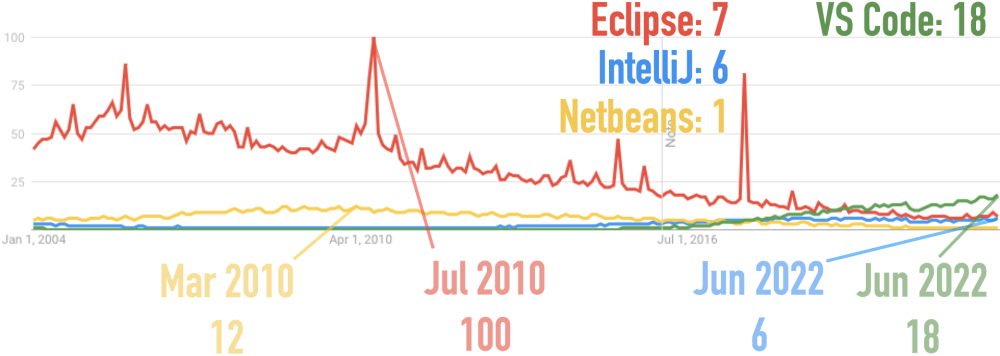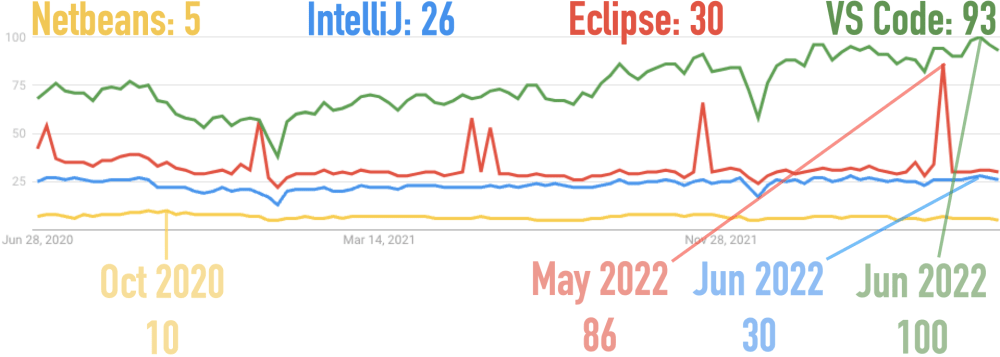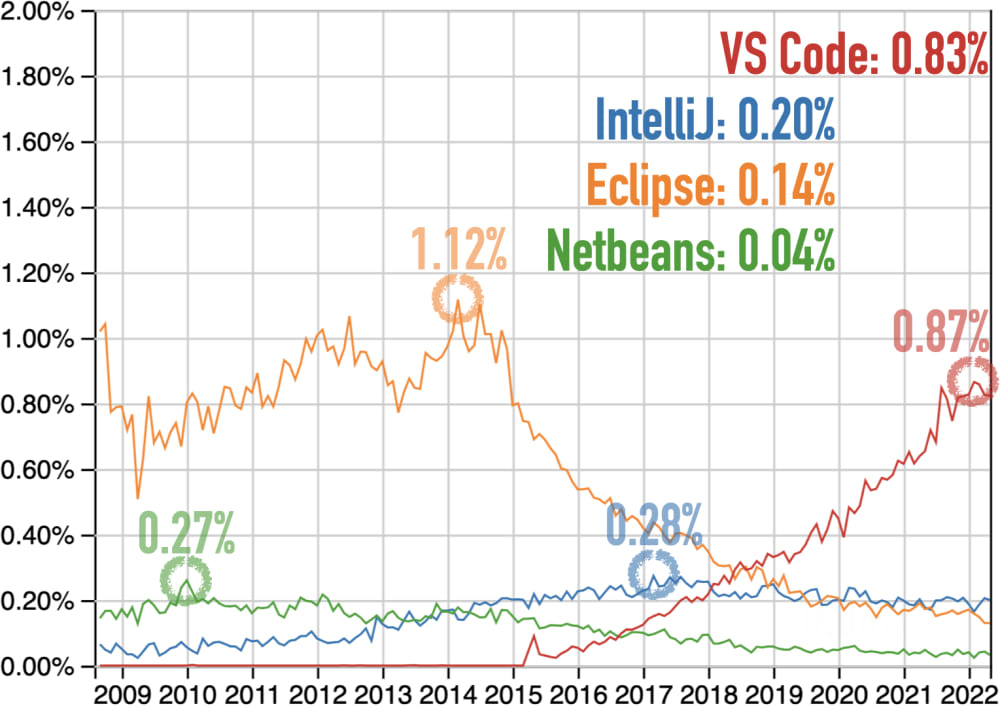Java Full-Stack Index Q3/2022: IDEs
Summary for Q3/2022
- Popularity trend: Eclipse is the most popular Java IDE, though it has declined for many years. IntelliJ holds up well for a commercial product: Except for job ads, it’s neck-to-neck with Eclipse. NetBeans has slipped into irrelevancy. VS Code isn’t a fully-fledged Java IDE, but - apart from jobs - it’s 3-4 times as popular as Eclipse & IntelliJ.
- If you don’t want to spend money, then use Eclipse.
- If you may spend money, evaluate IntelliJ.
- Evaluate VS Code for non-Java work, like web development (I use it for all my websites).
- If you’re using NetBeans, move off of it - everybody else has (this is only a slight exaggeration).
Table Of Contents
Choices
Here are the choices in alphabetical order:
Please note:
- IntelliJ is the only commercial IDE on this list. The free Community edition lacks crucial features of the Ultimate Edition, such as tools for Spring, Jakarta EE, and web development. Please see here for pricing. You can also buy the “All Products Pack”, which may be a better value (I use DataGrip for databases). These prices will go up 15% in October.
- Microsoft doesn’t position VS Code as a fully-fledged IDE and is “not made to compete with IntelliJ directly in that realm”.
Popularity
Why Popularity - and How?
Picking a popular technology makes our developer life easier: Easier to learn, easier to build, debug & deploy, easier to hire, and easier to convince teammates & bosses. Now popularity can make a difference in two situations: When multiple technologies score the same, we could go for the most popular one. And when a technology is very unpopular, we may not use it.
I measure popularity among employers and developers as the trend between competing technologies. I count mentions in job ads at Indeed for employer popularity. For developer popularity, I use Google searches, Udemy course buyers, and Stack Overflow questions.
Employers: Job Ads
The Indeed job search is active in 62 countries representing 89% of the worldwide GDP in 2020. It demonstrates the willingness of organizations to pay for a technology - the strongest indicator of popularity in my mind. IntelliJ is the baseline.

Eclipse wins, IntelliJ is second, VS Code third, and NetBeans last. Eclipse leads IntelliJ 2.7:1. Its numbers may be a bit too high, as Eclipse also has many frameworks, and the search only checks for “Eclipse”, not “Eclipse IDE”. VS Code is neck-to-neck with IntelliJ. NetBeans is an also-run.
Please see here for details, caveats, and adjustments of the job ad mentions.
You can find the detailed search results with links here. They include breakdowns by continents:
Developers
Courses Bought at Udemy
Udemy is one of the biggest online learning sites. They publish the number of courses and students beyond a certain threshold (possibly around 100,000 students). This shows how many people evaluate a technology. This time, Eclipse is the baseline.

VS Code wins, Eclipse is second. VS Code leads Eclipse 3.2:1. Neither IntelliJ nor NetBeans have enough students for Udemy to reveal their number.
Here are the links that show the courses for all and the number of students for some:
Google Searches
Google Trends demonstrates the initial interest in a technology over time. “More searches = better” to me.

This link produces the chart above.
The decline of Eclipse (17 years) and NetBeans (12 years) is clearly visible, as is the rise of VS Code. Let’s zoom in on the last two years:

This link produces the chart above.
VS Code wins, Eclipse is second, IntelliJ third, and NetBeans fourth. VS Code just hit its all-time peak. Eclipse has spikes around its quarterly releases. IntelliJ has been flat for 5 years.
Questions at Stack Overflow
Stack Overflow Trends shows which percentage of questions at Stack Overflow has a particular technology tag. It is a proxy for using a technology during evaluation and productive use. “More questions = better” to me.

This link produces the chart above.
VS Code wins, Eclipse is second, IntelliJ third, and NetBeans fourth. VS Code has risen for 7 years and is slightly off its all-time peak from early 2022. Eclipse and NetBeans have declined for 8 years, IntelliJ for 5 years.
Analysis
- Eclipse: Despite its decline, it’s still the most popular free Java IDE. The free IntelliJ Community Edition is no competition as it lacks support for back-end frameworks like Spring or Jakarta EE and web frameworks. But the cracks show: In Stack Overflow’s “2022 Developer Survey”, 72% of 8,866 respondents dread using Eclipse. And VS Code puts Eclipse on notice. So Eclipse has a VS Code competitor in the works.
- IntelliJ: In a world where everybody and their dog offer us free development tools, IntelliJ Ultimate Edition stands out as a product people are willing to pay for. Why? Because developers are happy with it: In Stack Overflow’s “2022 Developer Survey”, 68% of 19,723 developers love IntelliJ. Still, JetBrains also works on a VS Code clone.
- NetBeans: Moving from Sun to Oracle to Apache hasn’t done the oldest Java IDE in this list any good. It competes against the much more popular Eclipse IDE, not to mention VS Code. Feature-wise, there isn’t anything really to set NetBeans apart from Eclipse. And in Stack Overflow’s “2022 Developer Survey”, 77% of 8,866 respondents dread using NetBeans. That’s the worst score there - ouch.
- VS Code: It may not be a fully-fledged Java IDE. But it is something we developers have never had - a free, fast, cross-platform, cross-language IDE. And developers love it: In Stack Overflow’s “2021 Developer Survey”, VS Code took the top IDE spot (I don’t count Neovim as an actual IDE). 81% of 52,523 developers loved it - that’s 2% more than last year. The only way is up for VS Code!
So here’s my recommendation:
- If you don’t want to spend money, then use Eclipse.
- If you may spend money, evaluate IntelliJ.
- Evaluate VS Code for non-Java work, like web development (I use it for all my websites).
- If you’re using NetBeans, move off of it - everybody else has (this is only a slight exaggeration).